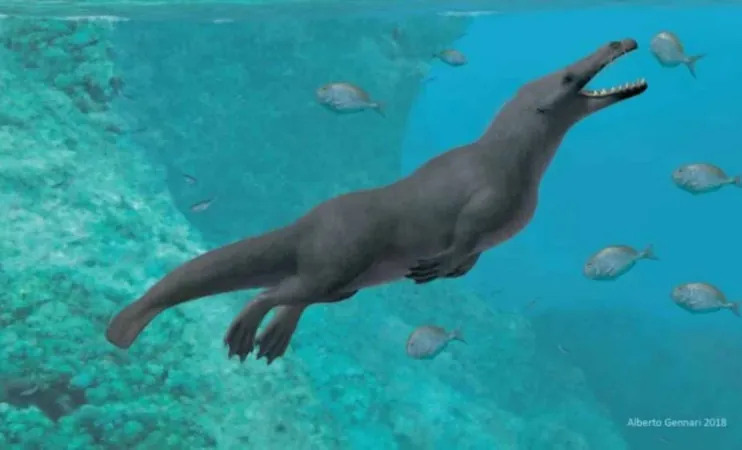
Are We on the Brink of a New Pandemic? Melting Arctic Ice Might Release Deadly 'Zombie' Viruses!
2025-04-08
Author: Ling
Introduction
As the world continues to grapple with the aftermath of the Covid-19 pandemic, the looming question of what could trigger the next global health crisis is becoming ever more pressing. Climate scientists are now sounding the alarm, suggesting that the melting ice in the Arctic could hold the key to humanity's next potential nightmare—‘zombie’ viruses.
Ancient Pathogens in Permafrost
Recent research indicates that the melting ice caps at the North Pole may expose ancient pathogens that have been locked away in permafrost for millennia. These so-called 'Methuselah microbes' are capable of lying dormant in frozen soil and the bodies of prehistoric animals for tens of thousands of years, only to re-emerge as the climate continues to warm.
Warnings from Experts
Dr. Khaled Abass from the University of Sharjah highlights that "climate change is not simply melting ice—it's dismantling the barriers between diverse ecosystems, animal species, and humans." He warns that the thawing permafrost could unveil long-hidden bacteria or viruses that could potentially pose a threat to human health.
Scientific Discoveries
Scientists have known for over a decade that some microorganisms frozen in the Arctic still possess the potential to infect living organisms. In notable findings from 2014, researchers successfully isolated viruses from Siberian permafrost, proving their ability to infect living cells even after being frozen for thousands of years. More recently, a team revived an amoeba virus that had remained frozen for 48,500 years, underscoring these ancient viruses' potential viability.
Discoveries Outside the Arctic
Worryingly, researchers have even discovered dormant pathogens in other glacial regions. Last year, a remarkable find in western China unveiled 1,700 ancient viruses, some dating back approximately 41,000 years, nestled deep within a glacier. These viruses have managed to survive three major climate transitions.
The Risks of Release
The concern grows larger with the realization that once the ice or permafrost is disturbed or melts, these microbes can be released into the environment, where they might pose severe health risks. An alarming discovery in Siberia, where an ancient relative of the African swine fever virus was found in the intestines of a 27,000-year-old frozen wolf, exemplifies this risk. This virus was still capable of infecting amoebas, amplifying fears about ancient pathogens emerging into today's ecosystems.
Impact on Modern Ecosystems
As the permafrost continues to melt at accelerating rates—an estimated four sextillion (that's 4 followed by 21 zeros) cells escape yearly—a small fraction of those ancient pathogens could disrupt modern ecosystems. A striking incident in 2016 noted a lethal anthrax outbreak that resulted from spores released from an animal carcass frozen in the Siberian tundra for 75 years—resulting in hospitalizations and fatalities.
Zoonotic Disease Concerns
Zoonotic diseases, which jump from animals to humans, account for about three-quarters of all known human infections, raising significant alarm regarding the potential of newly released pathogens. If prehistoric diseases re-emerge from their frozen state, the human immune system may be unprepared to combat them, leading to a potentially catastrophic outbreak.
Interconnectedness of Climate and Health
Dr. Abbas emphasizes the interconnectedness of climate change and public health, stating, "As the Arctic warms faster than other regions, we are witnessing significant environmental shifts that could facilitate the spread of infectious diseases between wildlife and humans."
Medical Infrastructure Challenges
Adding to the urgency is the lack of adequate medical infrastructure in Arctic regions. If a disease were to emerge, it could spread rapidly before authorities could mobilize an effective response.
Emerging Zoonotic Threats
With zoonotic threats already manifesting in the Arctic—diseases like Hantavirus hemorrhagic fever and the Toxoplasma gondii parasite have begun to circulate—scientists warn that what unfolds in the Arctic will not remain isolated. The ramifications of environmental changes in the far north may ripple across the globe, compelling nations to act swiftly to safeguard public health.
Conclusion
As we stand at the precipice of climate change's far-reaching consequences, one can't help but wonder: Are we truly prepared for what the melting Arctic might unleash? Stay alert; the next pandemic could be lurking beneath the ice.




 Brasil (PT)
Brasil (PT)
 Canada (EN)
Canada (EN)
 Chile (ES)
Chile (ES)
 Česko (CS)
Česko (CS)
 대한민국 (KO)
대한민국 (KO)
 España (ES)
España (ES)
 France (FR)
France (FR)
 Hong Kong (EN)
Hong Kong (EN)
 Italia (IT)
Italia (IT)
 日本 (JA)
日本 (JA)
 Magyarország (HU)
Magyarország (HU)
 Norge (NO)
Norge (NO)
 Polska (PL)
Polska (PL)
 Schweiz (DE)
Schweiz (DE)
 Singapore (EN)
Singapore (EN)
 Sverige (SV)
Sverige (SV)
 Suomi (FI)
Suomi (FI)
 Türkiye (TR)
Türkiye (TR)
 الإمارات العربية المتحدة (AR)
الإمارات العربية المتحدة (AR)